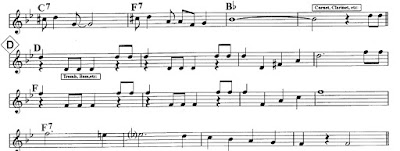 |
| Here is the dogfight in 'That's a Plenty'. It begins at the top right, where you see cornet and clarinet instructed to play the high Ds. The trombone and bass then respond with the low Ds. |
I am indebted to my Canadian friend Stephen Brown for teaching me a new term that describes a feature in the structure of some of our tunes. The word is 'Dogfight'.
Stephen told me that for a full explanation, it is best to go to:
But if you are happy with a brief explanation of how it mostly turns up in traditional jazz, I can tell you the Dogfight is a special kind of 'Bridge'. The Bridge is a link (often eight or twelve bars) between one theme and another in tunes that have more than one theme. What is distinctive about the Dogfight-style bridge is that usually a higher voice (generally the trumpet) plays a short phrase and then there is a short-phrase response from a lower voice (e.g. trombone or tuba) - thus creating a sort of musical dogfight. Get it? A vivid and useful term, isn't it?
If you know our music well, you will notice there are Dogfight links in such pieces as That's a Plenty, Clarinet Marmalade, High Society, and King Porter Stomp.
If you know our music well, you will notice there are Dogfight links in such pieces as That's a Plenty, Clarinet Marmalade, High Society, and King Porter Stomp.
If you are still having trouble grasping the idea, listen to this video which was put up on YouTube by my 'adopted grand-daughter' Haruka Kikuchi! You can hear the Dogfight (in this case a 12-bar Dogfight) from 1 minute 7 seconds to 1 minute 19 seconds, and again from 2 minutes 46 seconds to 2 minutes 59 seconds.
